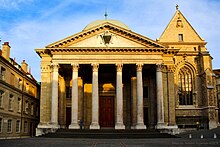
An altarpiece is an work of art in painting, sculpture or relief representing a religious subject made for placing at the back of or behind the altar of a Christian church. Though most commonly used for a single work of art such as a painting or sculpture, or a set of them, the word can also be used of the whole ensemble behind an altar, otherwise known as a reredos, including what is often an elaborate frame for the central image or images. Altarpieces were one of the most important products of Christian art especially from the late Middle Ages to the era of Baroque painting.

St. Martin's Cathedral, Utrecht, or Dom Church, is a Gothic church dedicated to Saint Martin of Tours, which was the cathedral of the Diocese of Utrecht during the Middle Ages. It is the country's only pre-Reformation cathedral, but has been a Protestant church since 1580.

The Cathedral of St. Michael and St. Gudula, usually shortened to the Cathedral of St. Gudula or St. Gudula by locals, is a medieval Roman Catholic cathedral in central Brussels, Belgium. It is dedicated to Saint Michael and Saint Gudula, the patron saints of the City of Brussels, and is considered to be one of the finest examples of Brabantine Gothic architecture.
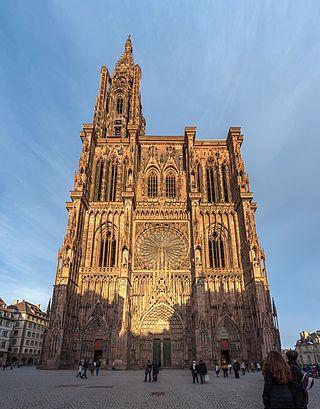
Strasbourg Cathedral or the Cathedral of Our Lady of Strasbourg, also known as Strasbourg Minster, is a Catholic cathedral in Strasbourg, Alsace, France. Although considerable parts of it are still in Romanesque architecture, it is widely considered to be among the finest examples of Rayonnant Gothic architecture. Architect Erwin von Steinbach is credited for major contributions from 1277 to his death in 1318, and beyond through his son Johannes von Steinbach, and his grandson Gerlach von Steinbach, who succeeded him as chief architects. The Steinbachs’ plans for the completion of the cathedral were not followed through by the chief architects who took over after them, and instead of the originally envisioned two spires, a single, octagonal tower with an elongated, octagonal crowning was built on the northern side of the west facade by master Ulrich Ensingen and his successor, Johannes Hültz. The construction of the cathedral, which had started in the year 1015 and had been relaunched in 1190, was finished in 1439.

The Cathedral of Saint Peter of Beauvais is a Catholic church in the northern town of Beauvais, Oise, France. It is the seat of the Bishop of Beauvais, Noyon and Senlis.
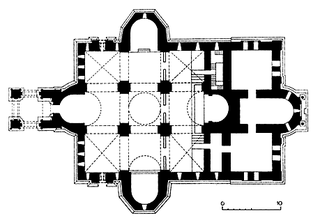
Church architecture refers to the architecture of buildings of churches, convents, seminaries etc. It has evolved over the two thousand years of the Christian religion, partly by innovation and partly by borrowing other architectural styles as well as responding to changing beliefs, practices and local traditions. From the birth of Christianity to the present, the most significant objects of transformation for Christian architecture and design were the great churches of Byzantium, the Romanesque abbey churches, Gothic cathedrals and Renaissance basilicas with its emphasis on harmony. These large, often ornate and architecturally prestigious buildings were dominant features of the towns and countryside in which they stood. However, far more numerous were the parish churches in Christendom, the focus of Christian devotion in every town and village. While a few are counted as sublime works of architecture to equal the great cathedrals and churches, the majority developed along simpler lines, showing great regional diversity and often demonstrating local vernacular technology and decoration.

Rouen Cathedral is a Catholic church in Rouen, Normandy, France. It is the see of the Archbishop of Rouen, Primate of Normandy. It is famous for its three towers, each in a different style. The cathedral, built and rebuilt over a period of more than eight hundred years, has features from Early Gothic to late Flamboyant and Renaissance architecture. It also has a place in art history as the subject of a series of impressionist paintings by Claude Monet, and in architecture history as from 1876 to 1880, it was the tallest building in the world.

Saint Peter's Church is a Brick Gothic church in Malmö, Sweden. Built in the 14th century as the main church of the city, it has been described as "the main Gothic monument within church architecture in Skåne". The church was a spiritual centre during the Reformation, and was one of only a few churches in what was at the time medieval Denmark that suffered damage due to iconoclasm as a consequence of the Reformation. St. Peter's Church contains late medieval murals of recognized high quality, as well as a number of unusual furnishings. The altarpiece, made in 1611, is one of the largest in the Nordic countries.

Sens Cathedral is a Catholic cathedral in Sens in Burgundy, eastern France. The cathedral, dedicated to Saint Stephen, is the seat of the Archbishop of Sens.

Toulouse Cathedral is a Roman Catholic church located in the city of Toulouse, France. The cathedral is a national monument, and is the seat of the Archbishop of Toulouse. It has been listed since 1862 as a monument historique by the French Ministry of Culture.

Nantes Cathedral, or the Cathedral of St. Peter and St. Paul of Nantes, is a Roman Catholic Gothic cathedral located in Nantes, Pays de la Loire, France. Construction began in 1434, on the site of a Romanesque cathedral, and took 457 years to finish in 1891. It has been listed since 1862 as a monument historique by the French Ministry of Culture.

The Calvin Auditorium or Calvin Auditory, originally the Notre-Dame-la-Neuve Chapel, is a chapel in Geneva, Switzerland, which played a significant role in the Protestant Reformation. It is associated with John Calvin, Theodore Beza and John Knox.

The Protestant Reformation during the 16th century in Europe almost entirely rejected the existing tradition of Catholic art, and very often destroyed as much of it as it could reach. A new artistic tradition developed, producing far smaller quantities of art that followed Protestant agendas and diverged drastically from the southern European tradition and the humanist art produced during the High Renaissance. The Lutheran churches, as they developed, accepted a limited role for larger works of art in churches, and also encouraged prints and book illustrations. Calvinists remained steadfastly opposed to art in churches, and suspicious of small printed images of religious subjects, though generally fully accepting secular images in their homes.

Senlis Cathedral is a Roman Catholic church and former cathedral in Senlis, Oise, France.
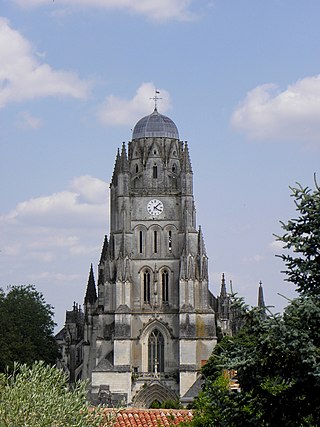
Saintes Cathedral is a former Catholic church located in Saintes, France. The cathedral is a national monument.
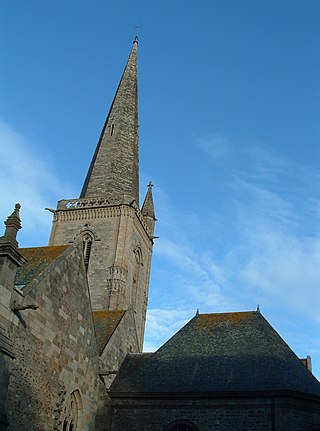
Saint-Malo Cathedral is a Catholic Cathedral located in Saint-Malo, Brittany, France. The church was founded in dedication to Saint Vincent of Saragossa and is a national monument of France. It was built in a mix of Romanesque and Gothic styles during the episcopacy of Jean de Châtillon (1146-1163) on the site of an ancient church founded in the 7th century. The cathedral suffered damage during World War II when the steeple toppled onto the Sacred Heart Chapel. An organ which had been built in 1893 by Louis Debierre was destroyed. On 21 May 1972, after 28 years of work, a ceremony was held to celebrate the completion of the restoration. It is a stop on the Tro Breizh, a Catholic pilgrimage that links the towns of the seven founding saints of Brittany.

Maillezais Cathedral is a ruined Roman Catholic church in the commune of Maillezais in the Vendée, France. Formerly the site of the Abbey of Saint-Pierre, the site grew from the 10th century abbey to the cathedral completed in the 15th century, with the many structures at the site abandoned by the end of the 17th century. Today's ruins consist of a cathedral, refectory, dormitory, kitchen, cellars, turrets and ramparts. The cathedral has been declared a heritage monument in reflection of its Romanesque and Gothic architectural form. It was designated a monument historique on 30 January 1924. The cathedral belonged to the Diocese of Luçon, with Roman Rites, and with St. Peter as the patron saint.

The Cathedral of St Peter the Apostle is a Catholic church located in Jaca, in Aragon, Spain. It is the seat of the Diocese of Jaca.
Jeanne de Jussie was a Genevan Roman Catholic nun and writer. She documented the role of the Protestant Reformation in the Poor Clares convent in Geneva.

The Basilica of Notre Dame of Geneva is a Roman Catholic church and Minor Basilica located in Geneva, Switzerland. It is dedicated to the Blessed Virgin Mary.
